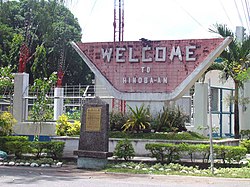Hinoba-an
Asia | |
|---|---|
| Municipality of Hinoba-an | |
 "Welcome" sign board along the highway | |
| Motto: Paspas Hinobaan | |
 Map of Negros Occidental with Hinoba-an highlighted | |
Location within the Philippines | |
| Coordinates: 9°36′06″N 122°28′01″E / 9.601789°N 122.466833°E | |
| Country | Philippines |
| Region | Negros Island Region |
| Province | Negros Occidental |
| District | 6th district |
| Founded | November 20, 1948 |
| Barangays | 13 (see Barangays) |
| Government | |
| • Type | Sangguniang Bayan |
| • Mayor | Daph Anthony V. Reliquias |
| • Vice Mayor | Jefre L. Encoy |
| • Representative | Mercedes K. Alvarez |
| • Municipal Council | Members |
| • Electorate | 38,279 voters (2022) |
| Area | |
| • Total | 414.50 km2 (160.04 sq mi) |
| Elevation | 78 m (256 ft) |
| Highest elevation | 687 m (2,254 ft) |
| Lowest elevation | 0 m (0 ft) |
| Population (2020 census)[3] | |
| • Total | 60,865 |
| • Density | 150/km2 (380/sq mi) |
| • Households | 14,099 |
| Economy | |
| • Income class | 1st municipal income class |
| • Poverty incidence | 32.34 |
| • Revenue | ₱ 252.4 million (2020) |
| • Assets | ₱ 434.6 million (2020) |
| • Expenditure | ₱ 247.3 million (2020) |
| • Liabilities | ₱ 155.7 million (2020) |
| Service provider | |
| • Electricity | Negros Occidental Electric Cooperative (NOCECO) |
| Time zone | UTC+8 (PST) |
| ZIP code | 6114 |
| PSGC | |
| IDD : area code | +63 (0)34 |
| Native languages | Hiligaynon Tagalog Cebuano |
| Website | www |
Hinoba-an, officially the Municipality of Hinoba-an (formerly Asia[5]), is a 1st class municipality in the province of Negros Occidental, Philippines. According to the 2020 census, it has a population of 60,865 people.[3]
Hinoba-an is the southernmost town of the province. It is bounded on the north by Sipalay City and Candoni; on the south by Basay, Negros Oriental; on the east by the town of Ilog; and on the west by the Sulu Sea. The total land area of Hinoba-an is 421.50 square kilometers. It is 187 kilometres (116 mi) from Bacolod and 154 kilometres (96 mi) from Dumaguete, the capital of Negros Oriental.
The town is home to the Magahat language, the indigenous language of Southern Negros as listed by the Komisyon ng Wikang Filipino. The language is vital to the culture and arts of the people.
- ^ Municipality of Hinoba-an | (DILG)
- ^ "2015 Census of Population, Report No. 3 – Population, Land Area, and Population Density" (PDF). Philippine Statistics Authority. Quezon City, Philippines. August 2016. ISSN 0117-1453. Archived (PDF) from the original on May 25, 2021. Retrieved July 16, 2021.
- ^ a b Census of Population (2020). "Region VI (Western Visayas)". Total Population by Province, City, Municipality and Barangay. Philippine Statistics Authority. Retrieved 8 July 2021.
- ^ "PSA Releases the 2021 City and Municipal Level Poverty Estimates". Philippine Statistics Authority. 2 April 2024. Retrieved 28 April 2024.
- ^ Republic Act No. 2154, Chan Robles, retrieved 2012



